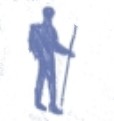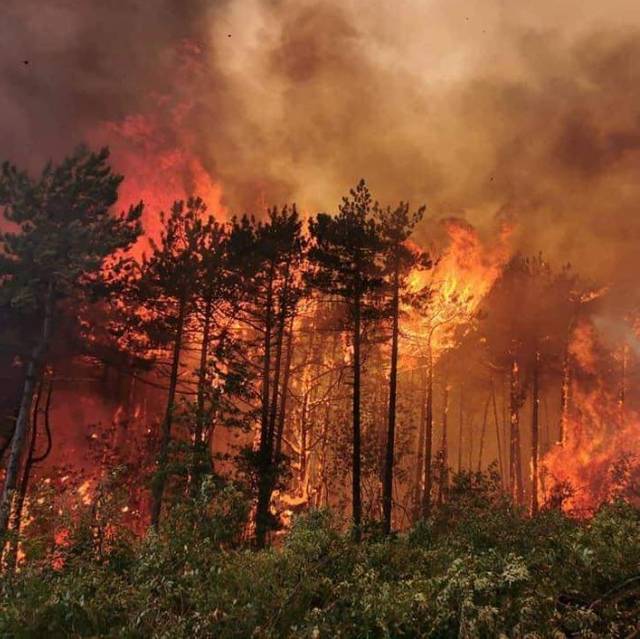For BBC Radio 4: From Our Own Correspondent
October 2022
Climbing a mountainside above Renče, a village in western Slovenia, for a moment I thought that autumn had come early. The supposedly evergreen pines had turned a startling orange… but as I got closer I saw that the wood was charred black. Further up, the forest became an apocalyptic cathedral, with row upon row of blackened spires above stumps like twisted bodies. The air smelled of ash and smoke. An eagle circled high above, the only movement in the landscape.
I had been walking for eight days and was near the end of a hiking trail called Pot Miru, the Walk of Peace, which runs through the Julian Alps of Slovenia to Trieste in north-east Italy, on the Adriatic Sea. Winding through beech-forested valleys and over bare mountain peaks, along the emerald green Soča River with its gorges and waterfalls, the journey had revealed the astonishing beauty of this small Balkan state, the third most thickly forested country in Europe. It was hard to imagine a more apparently unspoiled place.
But things had not always been that way. The Walk of Peace was established to commemorate the Isonzo Front, one of the bloodiest front lines of the First World War. Between 1915 and 1917, Italian and Austro-Hungarian troops waged 12 brutal battles here, fighting on steep mountainsides and inhospitable rocky terrain with mortars, machine guns, mines, poison gas, flamethrowers, knives and even knuckle-dusters. One and a half million soldiers were killed or wounded on these slopes before the invading Italian troops were finally pushed back.
Evidence of that now inconceivable carnage is everywhere. The Walk of Peace connects fortifications, trenches, underground tunnel networks, cemeteries, charnel houses and monuments to the fallen. The ground is littered with rusted war iron – from vehicle parts and ration tins to unexploded ordinance – and century-old barbed wire sprouts from the soil like thorns. This wartime legacy is partly responsible for the charred devastation I found myself walking through towards the end of my journey.
The wildfires of summer 2022 were the worst in Slovenia’s history. Starting over the border in Italy, they rapidly spread across the Karst – the pine-covered limestone plateau between the Julian Alps and the sea – and raged for 17 days, burning 350,000 hectares of forest. An unprecedented drought and the region’s notorious Bora wind made the inferno bad enough, but it was also exacerbated by First World War shells and grenades, buried for over 100 years, randomly exploding in the intense heat of the flames.
‘There were hundreds of explosions,’ said Anja Sedevcic Lasic from the local tourist board when I met her at the Monument of Peace in Cerje. ‘After 70 they stopped counting. It was incredibly dangerous for the firefighters as no one knew when a bomb might explode. This was the front line, right here. It was really like a war zone.’
I heard this from numerous people I met: it was like being in a war. Thousands of firefighters from every part of Slovenia worked 12-hour shifts, facing a wall of orange flame that reached up to 40 metres high, while multiple explosions sounded through the smoke. Afterwards, stretches of the plateau resembled the First World War battlefield, with shell craters and trenches exposed beneath shattered, smoking stumps. It was, as one man said to me, as if the war had never gone away. The scale and ferocity of the fires linked disasters that seem to belong to different eras: climate change exposing the buried violence of Europe’s past.
‘They say the forest will take 100 to 150 years to recover,’ said Anja. ‘If there are no more fires.’ It seems an impossible ‘if’. With the climate of Slovenia getting ever hotter and drier, as in neighbouring Italy, more fires – even larger ones – are a near certainty.
As I walked on from the Karst, through rain that had come six weeks too late, I focused on two points of hope. One was that the response to the catastrophe was international, with helicopters, aircraft and other support provided by Italy, Austria, Hungary, Slovakia, Croatia and Serbia – nations that had once sent their children to fight and die here. A century later they had come together to battle a common enemy – the sort of cooperation we will all need in this hotter, drier future.
The other small point of hope was the ground beneath my boots. When I stopped thinking about war and looked closer at the blackened earth, I saw movement on a tiny scale: a beetle; a bee; a butterfly. And already, bursting up in the rain, the brilliant green of new growth – the start of recovery, however hard it will be.
Listen to this on BBC Radio 4’s From Our Own Correspondent. It starts around timecode 23:30.
Photograph courtesy of Turizem Miren-Kostanjevica


